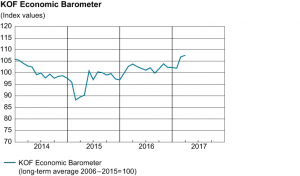In March 2017, the KOF Economic Barometer rose by 0.7 points to a new reading of 107.6. It thus reinforces its previous month’s climb to a level clearly above its long-term average. This indicates that the Swiss economy should grow at above average rates in the near future.
In March 2017, the KOF Economic Barometer climbed from 106.9 in February (revised down from 107.2) by 0.7 points to a level of 107.6. Accordingly, the Barometer not only confirmed the February reading, but even reached a slightly higher level. It thus stands markedly above its long-term average for the second time in a row, signaling above average growth rates for the near future.
The strongest positive contributions to this result come from the construction sector, followed by indicators relating to domestic private consumption and to the financial sector. Indicators regarding the manufacturing sector and the hospitality industry have practically remained unchanged. A slightly negative signal stems from the exporting industry.
Within the manufacturing industry, the unchanged overall outlook can be attributed to somewhat diverging signals. An improving sentiment is mainly visible amongst the architects. In addition, the electrical and the chemical industry are more optimistic than before.





